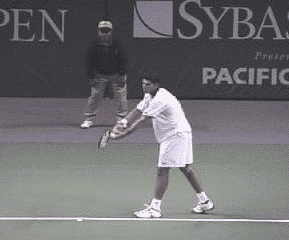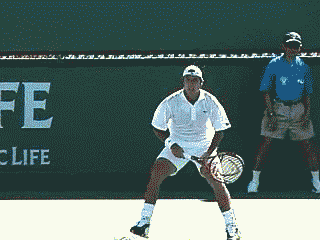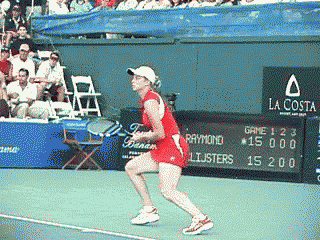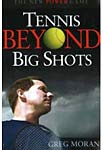| TennisOne Lessons The Forgotten Weapon Greg Moran Senior tennis has often been likened to a chess match and the analogy is a good one. Without the power that dominates, and I believe sometimes deteriorates the younger game, top senior players have learned to play a more strategic, cerebral brand of tennis, much like the game of kings.
In chess, the so-called "power pieces" are the queen and rook. These are the pieces that can inflict major damage in a hurry, much like the 130 mph serve of U.S. Open finalist Mark Philippoussis or the huge forehand of Andre Agassi. When a chess master loses his queen and rook, he can no longer rely on a strategy of power and must employ his less powerful pieces such as the bishop and knight in order to stay in the game. For the aging player who finds he can no longer hit the huge shots, as well as the junior and recreational player who cannot hit them consistently, the lob can serve as your knight or bishop. In his fabulous book "THINK TO WIN" Allan Fox describes the lob as one of the most "maligned, underused, and little-understood" shots in the game. The lob is not a "sexy" shot. It isn't a hard hit ball which brings the crowd to its feet and, as a result, many players relegate the shot to second class status. Another reason why the lob is the Rodney Dangerfield of tennis is that, for many players, the shot brings back painful memories of when they first started the game. If you watch two "C" players attempting to rally, you see them basically lobbing the ball back and forth because that is all, at that stage of their development, they are able to do. As a player moves up to the "B" level, they have learned to hit the ball harder and can, on occasion, hit that impressive crowd pleasing shot that everyone loves. Because they are now able to hit the ball hard, they believe that they should always hit the ball hard. They no longer want to lob because "that's how "C" players hit the ball."
So, in an age where power is king, players by-pass the lob in favor of that driving, impressive shot that they see the pros hit on television. The problem though is that this quest for the great shot more often than not results in an error. Remember, tennis is a game of errors and the player who makes the fewest errors will usually win the match. Errors are the bane of every player's existence and many, many errors are a result of poor shot selection. Instead of trying the high risk, albeit impressive looking shot, if players would learn to throw up a nice high, deep lob when they are off balance, they would be much more successful. Even the shortest, weakest lob is better than a ball in the fence or net for one simple reason---your opponent must now hit the ball. When in trouble, you always want to give your opponent one more opportunity to miss. You'll be amazed at how often they'll accommodate you, particularly when you force them to hit an overhead. Keep in mind that the overhead smash is one of the most difficult shots in the game to master and "most people at the recreational level do not possess reliable enough overheads to overpower a determined lobber," says Allan Fox. "They depend on the baseliner's macho instincts to tempt him to try difficult passing shots from bad positions rather than throw up high lobs and test their overheads (and nerves)."
Even if your lob is put away, you've still made your opponent hit that extra shot. Remember, the overhead is one of the most physically demanding shots in the game so if, when on the defensive, you make your opponent hit two or three overheads to end the point, fatigue will eventually creep in. Plus, an effective lobber will always keep the net rusher a little off-balance. Many players at the club and recreational level refuse to lob and as a result, their opponents charge the net like a bull in a china shop. By throwing up the occasional lob, the net rusher must always be aware of the possibility of a lob and, as a result, will not charge so aggressively or come in so close. How to Hit the Lob The mechanics for executing a basic lob are similar to hitting a groundstroke: early preparation, a short backswing, a low to high motion and a full, long follow-through. A successful lob is a combination of two things: lift and thrust. In other words, you must swing both up and out at the ball.
Keep in mind that the lob, like the drop shot, is a finesse stroke and like all shots that require touch, your wrist must be relaxed and flexible. You must also be patient and remember that trial and error are also necessary so that you can develop the necessary "touch." If you find that your lobs are landing too short, swing out more. If they are landing too low, swing up more. There are basically two types of lobs: offensive and defensive. A defensive lob is designed to keep you in a point while an offensive lob should set you up to win the point. You'll want to hit a defensive lob when you are in trouble. For example, your opponent has hit a strong approach shot and you are scrambling to reach it. Rather than trying a low percentage passing shot from an awkward area of the court, throw up a high defensive lob - high being the key word. A defensive lob is not meant to win the point. It might not even go over your opponents head. By hitting it very high, and preferably deep, you are giving yourself time to recover, get back into position or even catch your breath while your opponent has to decide how to play the ball. If your opponent decides to hit an overhead he or she will have a difficult time because the higher the ball has been hit, the faster it will fall, making it tougher to time. More often than not, if you have hit it high and deep enough, your opponent will be forced to let it bounce and will have to back away from the net to either hit the overhead after it has bounced or play the ball back with a groundstroke. Either way you have pushed your opponent off the net, giving yourself time to recover and forcing your opponent into a less threatening position.
The offensive lob is used in a different situation and with a different goal in mind. A player will hit an offensive point when he or she is in control of the point. "The best opportunity is when the volleyer's shot has landed short in the court and the lobber has the comfortable option of lobbing or passing," says Allan Fox. "Here," says Fox, "you can lean your weight into the court and the volleyer, sensing the passing shot, is likely to move forward. Because the backswing is so short, this type of lob is difficult to anticipate or read, and the ball gets over the volleyer's head before he knows what's hit him." An offensive lob is meant to be just that, offensive, so it should not be hit as high as a defensive lob. The lob should go just over the net players outstretched racket, making it extremely difficult to chase it down. Finally, remember that your opponent doesn't need to be charging the net for you to hit a lob. A favorite tactic of Jimmy Connors toward the end of his career was to, in the middle of a hard hitting rally; throw up a medium height lob deep into his opponent's backcourt. This tactic served many purposes. It changed the pace of the ball, the rhythm of the rally and, perhaps most important of all, it gave the 39 year-old Connors a chance to take a breather against his much younger opponents.
Tennis Beyond Big Shots presents a bold back-to-the-future approach. A new game that moves away from power and big shots yet is more lethal to opponents than any booming serve. Greg Moran shows players of all ages and abilities that, with simple and small changes, you can not only maximize your tennis wins and play longer, but also have much more fun doing it. Click link to purchase Greg Moran's book, Tennis Beyond Big Shots. |




